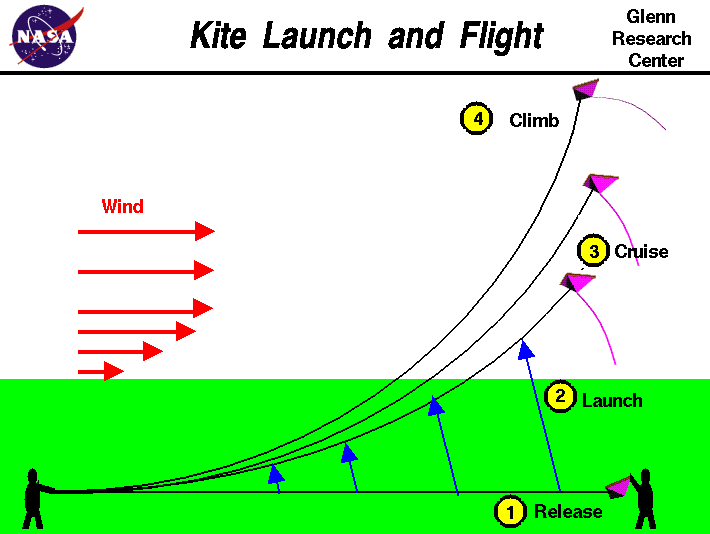
An excellent way for students to gain a feel for
aerodynamic forces
is to fly a
kite.
Kites come in a wide variety of shapes and sizes, and each kite flies
a little differently from another kite.
On this page we discuss the basics of kite flying
with a particular interest in the physics involved in launching
and flying the kite.
The motion of the kite through the air is the result of
forces
being applied to the kite. The kite responds to these forces according to
Newton's
laws of motion.
To launch the kite (1), we have to create a
lift
force which is greater than the
weight
of the kite.
The size of the lift force depends on a lot of
factors,
with the most important factor being the
velocity
of the air going by the kite. It does not matter whether the air blows over
the kite, or the kite is pulled through the air; the important factor for
generating lift is the
relative velocity
between the air and the kite. Now if we face the kite and have the
wind at our back, we already have some relative velocity provided
by the wind. On windy days, this velocity plus a small tug on the
line is usually enough velocity to lift the kite into the air.
On less windy days, we may have to move backwards or
run into the wind to get the kite flying. As the kite rises during
launch (2), we can usually stand
still and the kite will fly just fine. This occurs because the velocity of
the wind normally increases as we increase altitude.
The change in velocity from the surface of the
earth to some altitude is caused by the
boundary layer of the atmosphere. Inside the
boundary layer the velocity is low and may be unsteady. But with enough
altitude, the velocity (and the lift force) become fairly constant.
Once the kite has been launched, it will cruise (3) at an altitude and in
an attitude where all the forces and the torques
are balanced. If the forces are changed, the kite moves until the forces are
in balance once again. In particular, if we pull on the
control line,
we can slightly
increase the velocity of the kite. The increased velocity increases the lift,
which causes the kite to climb (4). If the wind velocity is even slightly higher
at the new altitude, the kite remains at that altitude. Letting out line initially
causes the kite to drop slightly due to the increased weight of the line, and
decreased tension in the line (slight decrease in velocity). But pulling on
the line can move the kite back up to a higher altitude.
There are mathematical equations which describe the forces and torques on the kite and the
sag
in the control line.
You can use the
KiteModeler computer program to solve these equations to get an approximation of the flight characteristics of your design.
You can then build your own kite from your design and compare the actual
flight performance to the computer prediction.
You can determine the
altitude at which your kite actually flies by using some simple math techniques and a
little graph paper. With a little more mathematical
knowledge you can even calculate the altitude at
which the kite is flying.
Enjoy flying ... but always fly
safely.
Activities:
Guided Tours
Navigation ..


- Beginner's Guide Home Page
|
